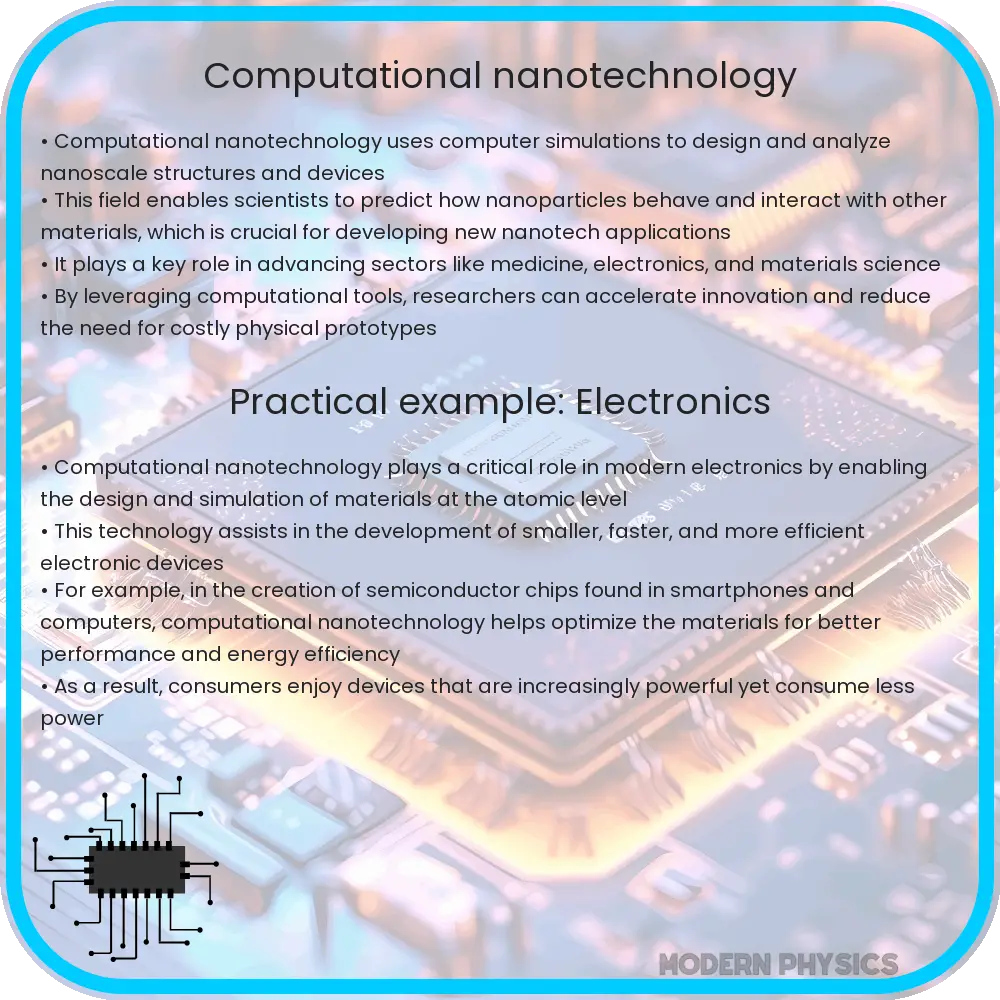Computational nanotechnology merges theoretical physics, computer science, and materials engineering to innovate at the nanoscale.

Introduction to Computational Nanotechnology
Computational nanotechnology is a dynamic field that blends theoretical physics, computer science, and materials engineering to explore and create materials at the nanoscale. This branch of technology leverages computational tools and simulations to design, analyze, and manipulate materials and devices with features that can be as small as a few nanometers. The implications of computational nanotechnology extend across various industries, including electronics, medicine, and energy, paving the way for innovations such as more efficient solar cells, targeted drug delivery systems, and enhanced electronic devices.
Understanding the Scale and Potential of Nanotechnology
Nanotechnology involves studying and manipulating matter at an incredibly small scale, typically between 1 to 100 nanometers. To put this in perspective, a single nanometer is one billionth of a meter. At this scale, materials exhibit properties that do not exist at the macro scale, such as increased strength, lighter weight, or enhanced chemical reactivity. These unique properties are harnessed to develop advanced materials and devices with superior performance.
The Role of Computational Tools in Nanotechnology
Computational tools are indispensable in the field of nanotechnology. They are used for modeling and simulating nanoscale phenomena, which are often impossible to observe directly. Key software tools in this area include molecular dynamics (MD) simulations, density functional theory (DFT), and finite element modeling (FEM). Each of these computational methods serves to provide insights into the materials’ electronic, mechanical, and thermal properties by simulating their behavior on an atomic or molecular level.
- Molecular Dynamics (MD) Simulations: These simulations provide a detailed view of the movement of atoms and molecules over time. They are crucial for understanding the dynamics of molecular systems and the effects of molecular interactions at the nanoscale.
- Density Functional Theory (DFT): DFT is a quantum mechanical method used to investigate the electronic structure of many-body systems, particularly atoms, molecules, and the solids’ condensed phases. It is fundamental in predicting material properties under different conditions.
- Finite Element Modeling (FEM): FEM breaks down large problems into smaller, simpler parts called finite elements. This method is used extensively in the analysis of complex structures and systems in nanotechnology, such as stress analysis in nano-composite materials.
Advancements Enabled by Computational Nanotechnology
Through the use of computational nanotechnology, researchers and engineers are able to design and optimize materials and devices with an unprecedented level of control. This section explores various advancements that computational nanotechnology has facilitated in the fields of electronics, healthcare, and energy.
Electronics
At the frontier of electronics, computational nanotechnology plays a crucial role in developing the next generation of semiconductors and transistors. By understanding and manipulating materials at the nanoscale, researchers can create devices that are more efficient, faster, and less energy-consuming than their current counterparts.
Healthcare
In the realm of healthcare, computational simulations help design nanoparticles that can deliver drugs precisely to target cells, minimizing side effects and improving the efficiency of treatments. This is particularly significant in the treatment of cancers, where targeted therapy is essential for the effective elimination of tumor cells while sparing healthy tissue.
Energy
Energy production and storage technologies also benefit greatly from nanotechnological innovations. Computational models help in designing better solar cells and more efficient batteries. For instance, nano-enhanced solar cells can convert sunlight to electricity more efficiently, and batteries with nanoscale engineered materials can have improved charge capacity and stability.
Challenges and Ethical Considerations in Computational Nanotechnology
Despite the exciting advancements and potential of computational nanotechnology, the field also faces several challenges and ethical considerations. These include the complexities of simulating real-world nanoscale behaviors accurately, high costs of computational resources, and concerns over the environmental impact and toxicity of nanomaterials.
Accuracy of Simulations
One of the significant challenges is the accuracy of nanoscale simulations. While computational tools have advanced, discrepancies still exist between simulated results and real-world experiments. This can be due to simplifications made in models or the inherent limitations of computational methods in capturing every aspect of nanoscale interactions.
Resource Intensity
Computational simulations, especially those involving large systems or complex materials, can be highly resource-intensive. They require substantial computational power, which can lead to high costs and energy consumption, raising sustainability concerns.
Ethical and Environmental Concerns
The development and deployment of nanotechnology must be handled with care to avoid potential negative impacts on health and the environment. The manipulation of materials at the molecular or atomic level could introduce new toxins or pollutants. Ethical guidelines and rigorous testing are crucial to address these issues proactively.
Future Prospects of Computational Nanotechnology
Looking towards the future, computational nanotechnology holds the promise of further transforming industries and improving human life. Enhanced computational power and more sophisticated algorithms are expected to resolve current limitations, leading to even more accurate simulations and innovative applications.
Integration with AI and Machine Learning
Integration of artificial intelligence (AI) and machine learning (ML) with computational nanotechnology is an emerging trend. These technologies can help in automating the design process, predicting new nanomaterials, and optimizing devices without extensive trial and error, thereby speeding up development cycles and reducing costs.
Personalized Medicine
In healthcare, continued advancements in nanotechnology could lead to more personalized medicine solutions. By combining patient-specific data and nanoscale delivery systems, treatments could be tailored to individual genetic profiles, enhancing effectiveness and reducing side effects.
Conclusion
Computational nanotechnology is a pioneering field that continues to push the boundaries of science and engineering. With its capability to manipulate materials at the most fundamental levels, it drives innovation across multiple domains, from electronics to healthcare. Despite the challenges such as simulation accuracy and ethical concerns, ongoing research and technological improvements are paving the way for a future where nanotechnology plays a central role in solving some of the most pressing global issues. As we advance, it is crucial to maintain a balance between innovation and responsibility to ensure sustainable and ethical development in this cutting-edge field.
